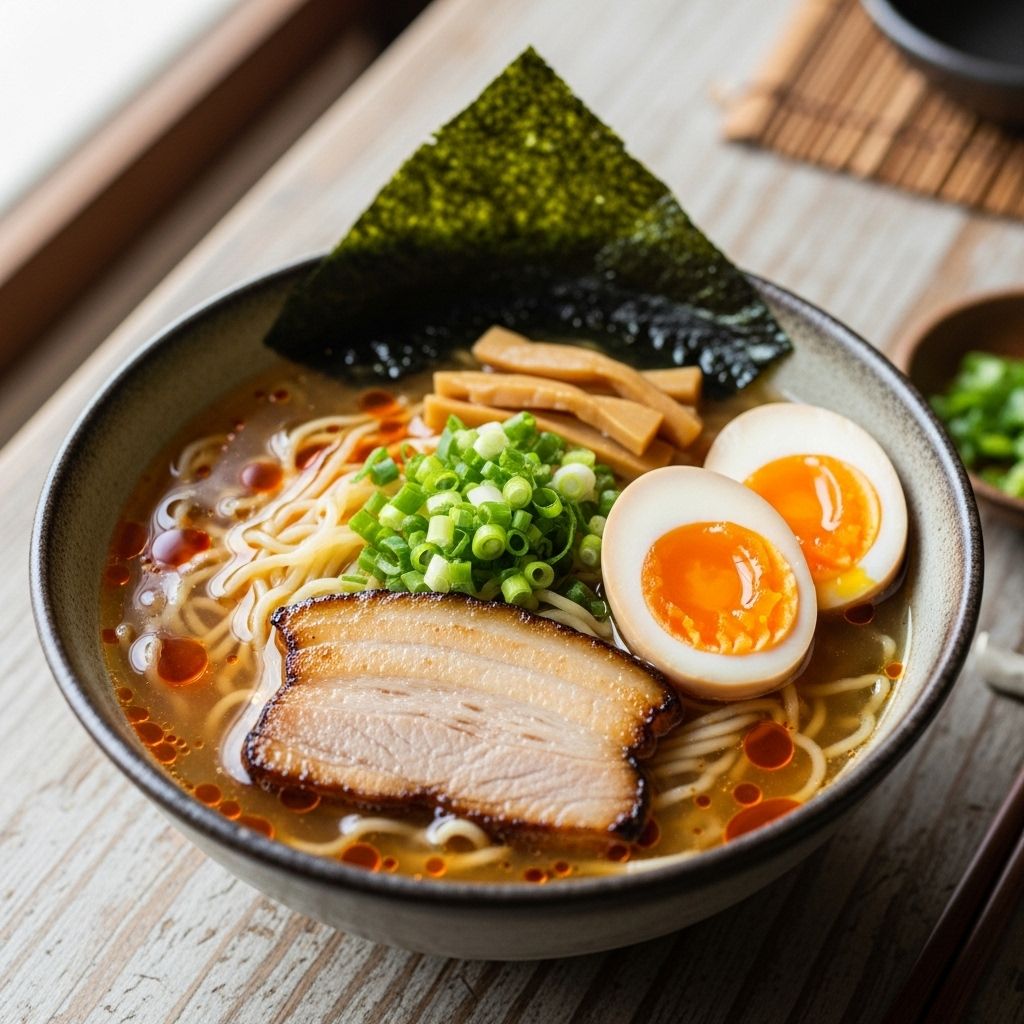How to Make Classic Homemade Ramen: Step-by-Step Guide to the Perfect Bowl
Layer umami-rich broth, seasoned tare, and springy noodles for a satisfying bowl.

Image: HearthJunction Design Team
Few dishes deliver comfort and satisfaction like a steaming bowl of homemade ramen. Unlike instant noodles, authentic ramen is an art form, built around layers of umami-rich broth, chewy noodles, flavorful tare, and creative toppings. Whether you’re an adventurous home cook or new to Japanese cuisine, this guide will show you how to assemble a restaurant-quality ramen bowl from scratch.
Why Make Homemade Ramen?
Ramen made at home puts you in complete control of ingredients, flavor, and nutrition. You can tailor the broth’s intensity, the noodle’s firmness, and the toppings to your personal taste. Plus, crafting each component is a rewarding process that connects you to Japanese culinary tradition.
Ramen 101: Understanding the Components
To create an unforgettable bowl, it’s important to understand ramen’s four essential building blocks:
- Broth (Dashi): The flavorful soup base—usually made from chicken, pork, and/or seafood, with aromatics and umami boosters like dried mushrooms or kombu.
- Tare: The concentrated seasoning, such as shoyu (soy), miso, or shio (salt).
- Noodles: Fresh, bouncy ramen noodles deliver the signature texture.
- Toppings: Traditional options include soft-boiled eggs, sliced pork, scallions, nori, and mushrooms.
Gathering Your Ingredients
Though ramen can be endlessly customized, the classic recipe includes a few key ingredients. Here’s what you’ll need to make 2 hearty servings of homemade ramen:
| Component | Ingredients |
|---|---|
| Broth (Chicken Dashi) | 4 cups low-sodium chicken broth, 1 sheet kombu, 1/2 cup dried bonito flakes, 4 dried shiitake mushrooms |
| Tare (Seasoning) | 3 tbsp light soy sauce, 2 tbsp mirin, 1 tbsp sake, 1 tsp freshly grated ginger, 1 tsp sugar |
| Noodles | 8 oz fresh ramen noodles (or high-quality dried) |
| Toppings | 2 soft-boiled eggs, 2 reserved shiitake mushrooms (from broth), 1/2 cup sliced scallions, 1/4 cup corn, roasted nori, chili oil, sliced pork (optional) |
Making the Broth (Chicken Dashi)
The hallmark of great ramen is a clear, umami-rich broth infused with subtle layers of aromatic flavor. Here’s how to build a classic chicken dashi:
- Soak the kombu and mushrooms: In a saucepan, combine chicken broth, kombu, and dried shiitake mushrooms. Let them soak for at least 30 minutes (room temp) to extract maximum flavor.
- Simmer gently: Bring the mixture just to a simmer over medium heat—do not let it boil. Once it starts to simmer, remove kombu promptly (about 5 minutes in), and let the mushrooms continue for 15 more minutes.
- Add bonito flakes: Remove from heat. Add bonito flakes. Let steep for 5 minutes, then strain well. Discard the solids but reserve the mushrooms for topping.
- Season lightly: Taste the dashi and season with a small pinch of salt if needed, remembering that tare will further season the broth.
Tip: For a vegetarian version, skip the bonito and use vegetable broth as a base, plus extra umami boosters like white miso or more mushrooms.
Crafting the Tare (Seasoning Sauce)
The tare is the concentrated seasoning at the bottom of each ramen bowl. It provides the main umami punch and balances the broth’s subtle flavors. The classic base is shoyu (soy sauce) tare:
- Combine soy sauce, mirin, sake, ginger, and sugar in a small saucepan.
- Bring to a gentle simmer. Allow flavors to meld for about 5 minutes. If you like it spicier, add a dash of chili oil.
- Set aside. Taste and adjust salt or sugar as needed.
Cooking Perfect Ramen Noodles
Fresh ramen noodles make a world of difference. Cook them immediately before serving so they stay springy and don’t over-soak the broth.
- Bring a large pot of water to a rolling boil.
- Add noodles and cook according to package instructions (typically 2-3 minutes for fresh, 4-5 minutes for dried). Stir gently to prevent sticking.
- Drain thoroughly and use immediately. Do not rinse.
The Best Soft-Boiled Ramen Eggs
Marinated ramen eggs (ajitsuke tamago) are iconic. Their gooey yolks and delicate savoriness elevate any bowl. Here’s a quick method:
- Use eggs at room temperature. Gently lower into boiling water and time for 6 minutes and 30 seconds.
- Transfer to ice water immediately to stop cooking. Peel carefully.
- Optional: Marinate peeled eggs for a few hours in a mix of soy sauce, mirin, and a splash of water.
Popular Ramen Toppings and Variations
- Shiitake mushrooms: Sliced and simmered with your broth, they add rich umami.
- Scallions: Sliced thin for crunch and freshness.
- Roasted nori (seaweed): Adds oceanic fragrance and drama.
- Sweet corn: For pops of sweetness and color.
- Chashu pork: Slices of slow-braised pork belly or shoulder for extra indulgence (optional).
- Sesame seeds, bamboo shoots, chili oil, and pickled ginger: For extra flavor and texture.
Assembling the Perfect Bowl
Once all the components are ready, it’s time to assemble. Here’s how to layer your ramen:
- Add tare: Place about 2-3 tablespoons tare in the bottom of each bowl (or to taste).
- Ladle broth: Pour in 1.5 to 2 cups hot chicken dashi and mix with the tare.
- Add noodles: Arrange a mound of just-cooked ramen noodles in the center.
- Add toppings: Place sliced mushrooms, half a ramen egg, scallions, corn, nori, and your creative extras on top.
- Finish: Drizzle with sesame oil, a sprinkle of chili oil, or a dash of freshly ground black pepper.
Tips and Tricks for Great Homemade Ramen
- Prep everything: Ramen comes together fast once you start assembling. Prep all toppings and components before you cook noodles.
- Customize your tare: Adjust the soy, mirin, and sugar ratio to suit your personal preference, or try a miso-based tare for complexity.
- Broth depth: Let the broth simmer gently to keep it clear, avoiding boiling to prevent cloudiness or bitterness.
- Add vegetables: Spinach, bok choy, or wilted kale add nutrition and color.
- Crispy garlic: Pan-fry sliced garlic in oil until golden and add for a savory crunch.
Popular Ramen Variations
| Style | Key Tare/Base | Signature Toppings |
|---|---|---|
| Shoyu Ramen | Soy sauce | Bamboo shoots, nori, pork, scallions |
| Miso Ramen | White or red miso | Corn, bean sprouts, ground pork, butter |
| Shio Ramen | Salt | Chicken, nori, pickled plums |
| Tonkotsu Ramen | Pork bone broth | Chashu, black garlic oil, wood ear mushrooms |
Recipe Recap: Classic Homemade Ramen
- Prep Time: 30 minutes (plus 30 min soaking optional)
- Cook Time: 40 minutes
- Servings: 2 generous bowls
Step-by-Step Summary
- Soak kombu and mushrooms in chicken stock for 30 minutes.
- Simmer, then remove kombu. Continue simmering mushrooms. Add bonito flakes (or skip for vegetarian), steep 5 minutes, and strain.
- Prepare tare: Simmer soy sauce, mirin, sake, ginger, and sugar for 5 minutes; set aside.
- Soft-boil eggs, peel, and marinate if desired.
- Cook ramen noodles last—drain, do not rinse.
- Assemble bowls: tare, broth, noodles, toppings.
Frequently Asked Questions (FAQs)
Q: Can I make the broth ahead of time?
A: Yes! The broth and tare can both be made 1-2 days ahead and refrigerated. Gently reheat before assembling the ramen.
Q: Are instant ramen noodles okay for homemade ramen?
A: If fresh ramen noodles aren’t available, use high-quality dried ramen or even discard the flavor packets from instant ramen and use just the noodles.
Q: What protein alternatives work besides pork?
A: Grilled chicken, tofu, or even shrimp work well as leaner or vegetarian-friendly toppings.
Q: How can I make my ramen spicier?
A: Stir chili oil, a spoonful of hot sauce, or freshly sliced chilies into the bowl for your preferred heat level.
Q: Can I freeze homemade ramen components?
A: Broth and tare freeze well (in separate containers). Noodles and eggs should be made fresh for best texture.
Nutritional Tips and Healthy Swaps
- Add greens: Boost nutrition with spinach, bok choy, or kale in each serving.
- Reduce sodium: Control salt by using low-sodium broth and limiting soy sauce additions.
- Whole-grain noodles: Try whole-wheat or rice-based noodles for extra fiber.
Serving and Presentation Tips
- Use wide bowls: Traditional ramen bowls show off all the toppings and make for easier slurping.
- Arrange toppings artfully: Fan mushrooms, eggs, corn, and other elements in sections to create visual interest.
- Serve hot: Heat bowls before assembly so every bite stays steamy and satisfying.
Final Thoughts
Homemade ramen is a deeply satisfying project, both to make and to share. As you gain confidence and experience, experiment with different broths, toppings, and seasonings. Before long, you’ll be savoring the perfect bowl of ramen any time you crave it—crafted with your own hands.
References
Read full bio of Anjali Sayee












